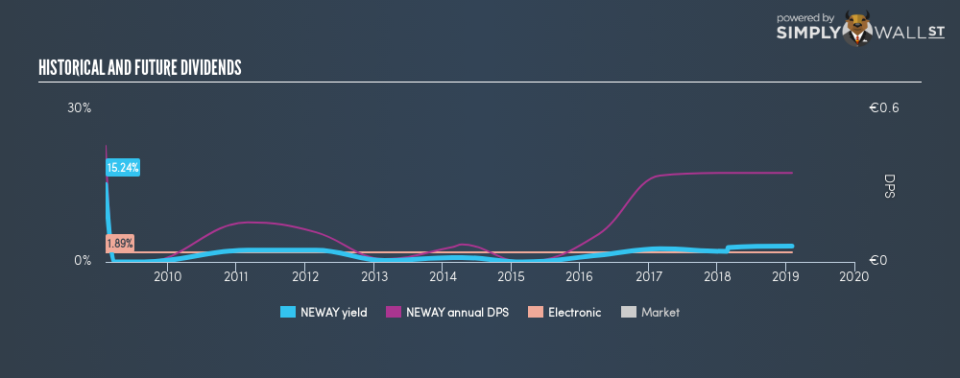Zooming in on AMS:NEWAY’s 3.1% Dividend Yield

Want to participate in a short research study? Help shape the future of investing tools and you could win a $250 gift card!
Dividends play a key role in compounding returns over time and can form a large part of our portfolio return. Historically, Neways Electronics International N.V. (AMS:NEWAY) has been paying a dividend to shareholders. Today it yields 3.1%. Does Neways Electronics International tick all the boxes of a great dividend stock? Below, I’ll take you through my analysis.
View our latest analysis for Neways Electronics International
5 checks you should do on a dividend stock
When researching a dividend stock, I always follow the following screening criteria:
Does it pay an annual yield higher than 75% of dividend payers?
Has it consistently paid a stable dividend without missing a payment or drastically cutting payout?
Has dividend per share amount increased over the past?
Is is able to pay the current rate of dividends from its earnings?
Will it be able to continue to payout at the current rate in the future?
How does Neways Electronics International fare?
Neways Electronics International has a trailing twelve-month payout ratio of 34%, which means that the dividend is covered by earnings. Furthermore, analysts have not forecasted a dividends per share for the future, which makes it hard to determine the yield shareholders should expect, and whether the current payout is sustainable, moving forward.
When considering the sustainability of dividends, it is also worth checking the cash flow of a company. Companies with strong cash flow can sustain a higher payout ratio, while companies with weaker cash flow generally cannot.
If there is one thing that you want to be reliable in your life, it’s dividend stocks and their constant income stream. Not only have dividend payouts from Neways Electronics International fallen over the past 10 years, it has also been highly volatile during this time, with drops of over 25% in some years. These characteristics do not bode well for income investors seeking reliable stream of dividends.
Relative to peers, Neways Electronics International produces a yield of 3.1%, which is high for Electronic stocks but still below the market’s top dividend payers.
Next Steps:
Now you know to keep in mind the reason why investors should be careful investing in Neways Electronics International for the dividend. But if you are not exclusively a dividend investor, the stock could still be an interesting investment opportunity. Given that this is purely a dividend analysis, you should always research extensively before deciding whether or not a stock is an appropriate investment for you. I always recommend analysing the company’s fundamentals and underlying business before making an investment decision. Below, I’ve compiled three fundamental factors you should further examine:
Future Outlook: What are well-informed industry analysts predicting for NEWAY’s future growth? Take a look at our free research report of analyst consensus for NEWAY’s outlook.
Valuation: What is NEWAY worth today? Even if the stock is a cash cow, it’s not worth an infinite price. The intrinsic value infographic in our free research report helps visualize whether NEWAY is currently mispriced by the market.
Dividend Rockstars: Are there better dividend payers with stronger fundamentals out there? Check out our free list of these great stocks here.
To help readers see past the short term volatility of the financial market, we aim to bring you a long-term focused research analysis purely driven by fundamental data. Note that our analysis does not factor in the latest price-sensitive company announcements.
The author is an independent contributor and at the time of publication had no position in the stocks mentioned. For errors that warrant correction please contact the editor at editorial-team@simplywallst.com.

